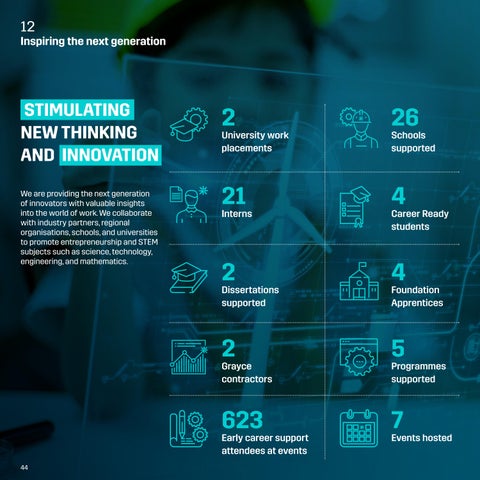Annual Review
April 2022 - March 2023




01 A year in review 3 02 Galvanising green growth 6 03 A year of strong delivery 8 04 Innovating the future 10 05 Advancing Scotland’s net-zero economy 18 06 Accelerating start-ups 22 07 Global perspectives 28 08 Research and academia 32 09 Culture of collaboration 36 10 Insight and foresight 40 11 Sustainability at our core 42 12 Inspiring the next generation 44 13 Financials and governance 46
Martin Gilbert Chairman

As Chairman of the Net Zero Technology Centre (NZTC), it is my pleasure to present our Annual Report for the year 2022. The work of the Centre is more important than ever as we focus on accelerating the development and deployment of technologies that can help achieve a net-zero future while addressing the critical issue of energy security.
The technologies and startups
NZTC has supported, and the energy transition projects it leads, are anchoring innovation and technology in Scotland, which is key to building resilience and creating new jobs. This year’s Open Innovation Programme resulted in a fantastic number of ideas submitted, and the final selection of 19 technologies are both innovative and inspiring.
The year-on-year achievements of NZTC are admirable and a testament to the commitment, passion, and hard work of the team. Technology developers we’ve supported during this and previous years have scaled both their technologies and their businesses, securing further field trials, raising investment, increasing employee numbers, and moving into new premises. TechX Pioneers have raised over £75M in equity since graduating the programme, this is no mean feat in challenging times, but shows the tenacity of these entrepreneurs.
This year I’ve also enjoyed seeing NZTC’s growth strategy come to life, with the launch of Net Zero Technology Services. It is fantastic to see the application of honed insight and foresight already making a significant impact on clients’ investment decisions and decarbonisation strategies. There is a world of opportunity for the Centre, united across regions and nations in pursuit of a common purpose, to reach net zero as quickly as possible.
Finally, I would like to express my gratitude to the NZTC Board, stakeholders, and staff for their dedication and hard work. I look forward to watching NZTC continue to evolve and grow as we build a sustainable future for generations to come.
3 01 A year
in review
PUSHING BOUNDARIES TO TURN NET ZERO AMBITIONS INTO A REALITY


As we close out another successful year for NZTC, we reflect on the wider factors that have once again put energy high on the agenda for not only governments and businesses, but the average person. Global energy markets experienced significant turbulence over the past year and monumental challenge, as the world continued to emerge from the pandemic, Russia invaded Ukraine with devastating impact on the Ukrainian people, and a cost-of-living crisis envelops our nation. The UK has been forced to confront its dependence on foreign energy sources and recognise the need to diversify its energy mix and reduce its reliance on imports.
More so than ever it has become clear and widely appreciated that innovation is key to achieving a more resilient and cost-effective energy system and meeting the UK’s net zero targets. As a centre with net zero at its core, we continued to address complex technology challenges and co-invest in research and development with the public and private sectors to accelerate technological innovation.
This year we took our ‘call for ideas’ a step further and announced our first open innovation programme, which resulted in 20 game-changing net zero technologies securing combined support of over £20 million - £8 million from NZTC and over £12 million cofunded by industry. We also marked a significant milestone in the delivery

of our Net Zero Technology Transition Programme, celebrating one year on for seven energy transition projects that are already well on their way to enabling Scotland to become a global leader in net zero technologies; as a manufacturer, designer, installer and operator of the next generation of energy systems.
We continued to champion a startup ecosystem, welcoming another 12 clean energy startups, which marks cohort five, to our TechX programme.
Our success is made possible by our people and the partners and businesses that participate and collaborate with us. The passion, commitment, curiosity, and the way in which they challenge convention are what drives not only NZTC forward but also help the UK to reach net zero faster. In recognition of our efforts in identifying, advocating, and implementing technology-driven projects, we were thrilled to be named by Reuters as one of the top global innovators for 2023, with special recognition for our collaborations and partnerships.
We continued to seize opportunities and this year marked an exciting progression in the next stage of NZTC’s growth, with the launch of Net Zero Technology Services. We have in place the right expertise, mindsets, strategies, and innovations to allow us to grasp the infinite possibilities for growth and continued success.
5
01 A year in review
Colette Cohen OBE CEO, Net Zero Technology Centre
DRIVEN BY A MISSION TO INNOVATE

02 Galvanising green growth
The world is grappling with the challenges of the energy trilemma – sustainability, security, and affordability. Each element can’t be addressed in isolation, so an integrated approach is required including technology that simultaneously improves all three aspects of the energy system.
Through the projects we support, the start-ups we accelerate and the partners we collaborate with, we have continued to deliver on our purpose of developing and deploying technologies that reduce emissions, unlock the full potential of an integrated energy system and propel the energy industry towards a digital, automated, affordable decarbonised future.
To reach net zero you can’t stand still, and our people have dedicated themselves to addressing some of the most complex and critical technology challenges facing our world today.

Our unwavering commitment to innovation has allowed us to make significant strides in advancing the development of next-generation solutions that address real-world challenges.
We were recognised by Reuters in their first Top 100 Innovators Report, which reflects on the state of innovation across the energy industry today and highlights the key players and disruptors. We were one of three organisations given a special mention for collaboration and partnerships.
This year we continue to evolve our strategy, embracing the opportunity for growth and diversification of our own business with the launch of Net Zero Technology Services. The new offering provides the energy industry and investors with insights and foresights on current and emerging net zero technologies, helping organisations leverage technology to navigate and accelerate their journey to net zero.
7
A year of strong delivery
April 2022 – March 2023
8 03
Since inception
9
Innovating the future
DISRUPTING THE STATUS QUO
Open Innovation Programme 2022












We are driving the adoption of clean and sustainable energy solutions that transform how we power our world.
Our 2022 Open Innovation Programme was aimed at technologies that will reduce offshore emissions, accelerate clean energy production, and enable delivery of the UK’s net zero ambitions.
A total of 154 businesses from across the globe applied for a total share of £20 million (£8 million from NZTC and £12 million co-funded by industry), with the potential of a maximum of £1 million awarded to each successful project.
The game changing technologies were put through a rigorous selection process ensuring each supports the transition towards net zero, with an obligation of trialling and deploying technology within the UK Continental Shelf. As well as funding, the 19 game-changing technology developers selected will gain access to data, facilities, and technical expertise from industry.
Our 2023 Open Innovation Programme opened for applications in January 2023, with a focus on digital solutions. These technologies will be showcased in the next annual report.
£20M Funding 154 Businesses applied
10 04
19 Game-changing technologies
85 Industry partners












This pioneering research and technology will pave the way to a sustainable energy future for the UK and the world.
The Scottish Government is fully committed to reach netzero by 2045 and programmes like this play an important role in reaching these targets. The Open Innovation Programme will aid our transition to netzero and will attract new jobs to the region, helping us to boost economic growth.
11
UK Government Minister for Scotland David Duguid
Scottish Government Business Minister Ivan McKee
Innovating the future 19 TECHNOLOGIES, ONE NET ZERO MISSION

CeraPhi Energy
Harnessing onshore geothermal in the UK.
A closed-loop technology that utilises a single wellbore to allow for extraction of geothermal energy without any formation stimulation. Can be readily applied to redundant hydrocarbon wells. Geothermal could deliver 20% of the UK’s energy mix by 2050 and provide heat for over 2 million homes.
Theme: Late Life and Decommissioning
Geothermal could deliver 20% of the UK’s energy mix by 2050
Sulmara
Minimising requirement for large survey vessels.
A fully unmanned surface vessel capable of gathering data in real time via an onshore remote command centre to support decommissioning and subsea inspection activities. Reduces costs by over 50% and results in an 85% reduction in carbon footprint when compared to traditional crewed vessel alternatives.
Theme: Late Life and Decommissioning
Reduces costs by over 50% and results in an 85% reduction in carbon footprint
isol8

Eliminating the risk of unplanned hydrocarbon escape due to failed cement barriers.
Composite alloy barrier material, AlloyCrete, provides long-term well integrity assurance. ‘Rigless’ plug and abandonment delivered on a wireline using isol8 alloy barriers cuts costs by at least 50%.
Theme: Well Integrity
50% cost saving
Pipetech
Removing scale to safeguard well integrity.
Downhole scale remediation tool for the cleaning of hydrocarbon wells to bring them back to bare metal with no damage. This technology has an overall CO2e impact associated of -1.27kt CO2e compared to conventional remediation.

Theme: Well Integrity
1.27kt C02e overall impact
Pipetech scale remediation tool
12 04
Play video
Copsys Technologies

Eliminating CUI using remote sensor technology.

Copsys Intelligent Digital Skin paint-based technology is a truly unique coating system used to digitally detect and locate coating damage. Has the potential to provide a 50% cost saving based on a one-time deployment over traditional strip and inspect methods.
Theme: Integrity Management - Corrosion Under Insulation (CUI)
50% cost saving
SubTeraNDT
Reducing risk of pipework failure and potential fugitive emissions.
A battery powered handheld terahertz inspection tool that detects CUI and moisture beneath a variety of common industrial coatings, insulations, and non-metallic cladding without the need for its removal. Has the potential to reduce emissions by 280Mt of CO2e.
Theme: Integrity ManagementCorrosion Under Insulation (CUI)
280Mt of C02e
Potential emissions reduction
Actuation Lab
Reducing maintenance burden of equipment corrosion.
Composite Callimorph pneumatic actuator made from corrosion-free composite materials. The technology has the potential to relieve the £368 million maintenance backlog of corroded and worn valve actuators in the UK energy industry.

Theme: Integrity ManagementCorrosion Under Insulation (CUI)
Potential to relieve £368M of maintenance backlog
Advanced Hall Sensors
Revolutionising the speed and accuracy of high resolution, non-contact magnetic imaging.
Novel QWHE Camera providing high resolution, non-contact magnetic imaging of corrosion under insulation. This technology delivers a 50% cost reduction over traditional strip and inspect methods.
Theme: Integrity ManagementCorrosion Under Insulation (CUI)
50% cost reduction
Copsys Intelligent Digital Skin paint-based technology
13
Play video
Innovating the future
HiiROC in partnership with Centrica

Demonstrating scalability and capability of plasma electrolysis hydrogen production.
Integration and demonstration of the HiiROC H2 production system to decarbonise gas peakers through hydrogen and showcasing CO2 sequestration through Solid Carbon at an existing ‘gas peaking’ plant. The overall CO2e impact associated with this technology is 1.18Mt CO2e per year through full integration in the peaking plant running at 1000 hours per year.

Innovatium Group

Dramatically improving energy storage.
Enertechnos Ltd
Delivering electrification and offshore transmission.
Enertechnos subsea Capacitive Transfer System is a novel lower loss power cable for use in offshore windfarms for the electrification of the North Sea.The project will convert current onshore application to an offshore version of the cable. Enables 25% more power to be transferred than a conventional cable and a 14% saving on a typical in-field electrical cable, saving £3M on a £21M project.
1.18Mt C02e overall impact per year
PRISMA Liquid Air Battery combines compressed air production and energy storage in the form of highly energy dense liquified air. It can be adapted for offshore installations to address the intermittency challenge of renewable power generation. One time development cost saving of £370k assuming conservative cost of energy and excluding installation and set up costs for development of first demonstrator.

Theme: Zero Emissions Power one-time £370k cost saving
Theme: Renewables 25% More power 14% Savings
Theme: Renewables
 Innovatium Group
Innovatium Group
14
PRISMA Liquid Air Battery
04
HiiROC ‘Gas peaking’ plant
Play video
Enertchnos Capacitive Transfer System
Play video
B9 Technologies
Overcoming membrane and compression challenges.

Development and validation of the high-efficiency B9 Flow-Field Electrolyser stack for low-cost hydrogen production. Proposed design forecast to reduce electrolyser CAPEX and OPEX by up to 30%, by eliminating platinum group metals and reducing the cost of electrodes through additive manufacturing.
Theme: Hydrogen 30% electrolyser reduction costs
sHYp
Producing green hydrogen from seawater.

Development of an integrated membrane-less electrolyser and electrochemical compression stack. The technology has a one-time development cost saving of £456k and an overall CO2e impact of -152 t CO2e compared to a standard PEM electrolyser.
Theme: Hydrogen one-time £456k cost saving
Ceimig
Reducing dependency on rare earth metals during electrolysis.
Development and testing of a substrate to reduce the amount of iridium required for polymer electrolyte membrane water electrolysis (PEM). This innovation will significantly reduce the amount of iridium required enabling a £1.5Bn cost saving if adopted across the 40GW of PEM electrolysers predicted to be deployed 2035.

Theme: Hydrogen £1.5Bn
Cost saving

15
Ceimig (PEM)
sHYp electrolyser
Innovating the future
Pace CCS Ltd
Understanding impact of polar impurities on carbon steel pipelines.
Software/ modelling system to predict the corrosive risk of aqueous phase liquids in CCS pipelines and wells induced by polar impurities. One time development cost saving of £10m - £250m based on savings in design of a single well (£10M) to a single catastrophic failure of CCS project.
Theme: Carbon Capture Utilisation Storage
£10-250M
Cost saving
Heriot-Watt University
Assuring long-term containment of stored CO2.
Risk-based, well decommissioning modelling framework to analyse and predict the leakage risk of legacy and future abandoned wells in CCS fields. One time development cost saving of £26m based on a single well repair by drilling relief well and killing the target well offshore.
Theme: Carbon Capture Utilisation Storage
£26M
Cost saving
Ai Exploration multispectral imaging sensor



Ai Exploration

Preventing corrosion in CCS environmental conditions.

Novel compact multispectral imaging sensor, accurately measures moisture in real time and eliminates the need for complex extractive systems. Leading to a 50% saving in installation and measurement costs and a one-time development cost saving of £1.4m based on the installation of 28 sensors on a single CCUS cluster.

Theme: Carbon Capture Utilisation Storage
£1.4M
Cost saving 50% Installation savings
16 04
WesternGeco
Tracking the progress of CO2 through targeted detection.

A paradigm shift away from 4D seismic reservoir monitoring to a plume-centric approach, this surface deployed distributed acoustic sensing monitoring system detects subsurface changes and enables more frequent monitoring . One time development cost saving of £5.43m - £8.04m and overall CO2e impact of -2.2kt CO2e per year compared to standard 4D surveys.
Theme: Carbon Capture Utilisation Storage
£5.43-8.04M



Cost saving
Enoflex






Proving effectiveness of alternative pipe materials.
Qualifying Single Polymer Composite pipes for low cost, efficient transportation of liquified cold CO2. One time development cost saving of £957k compared to a SS316 2km pipeline and an overall CO2e impact of -1.97kt CO2e per year compared to carbon steel pipelines.
Theme: Carbon Capture Utilisation Storage
£957k
Cost saving
We are promoting and expediting the development and deployment of innovative technologies to address the energy trilemma and accelerate the UK’s journey to net zero.
 Myrtle Dawes, Solution Centre Director, NZTC
Myrtle Dawes, Solution Centre Director, NZTC

17
Advancing Scotland’s net-zero economy
UNLEASHING A DECARBONISED FUTURE
Net Zero Technology Transition Programme: One year on


In 2021, NZTC was awarded a £16.5 million from the Scottish Government’s Energy Transition Fund, which has benefitted from further match-funding from industry to accelerate seven energy transition projects to help deliver Scotland’s net-zero economy.
One year on, these projects are currently underway through our Net Zero Technology Transition Programme (NZTTP) and this year we celebrated significant milestones:
05
Play video
This innovative partnership between industry and government, and the cutting edge technology behind it, will enable North Sea energy to lead on meeting that challenge, ushering in a new era of stronger energy security, with fewer emissions, at lower cost.
The OEDA project demonstrates how industry partners can come together and develop innovative solutions to facilitate wider data sharing. The programme will deliver part of the Data Sharing Fabric that was outlined in the Offshore Energy Data Strategy Taskforce, a key enabler of many data sharing opportunities across the sector.



19
Palantir UK Head, Louis Mosley
David Evans, Senior Digital and Data Consultant at Energy Systems Catapult
Advancing Scotland’s net-zero economy
TAKE A DEEP DIVE INTO SEVEN BOLD PROJECTS
Energy Hubs
Hydrogen Backbone Link
Creating multiple renewable energy hubs in strategic locations around the UK will integrate various energy vectors to meet national power demands and facilitate European and Worldwide energy export.
Since commencing, the project has highlighted the potential of replacing fossil fuels and provided a comprehensive overview of their use in Scotland, including offshore oil and gas, marine infrastructure, onshore industries, and transportation. The project has identified promising fuels for decarbonisation.
Laying the foundations for a hydrogen pipeline network linking proposed energy hubs, ports and other assets with centres of demand in the UK and Europe.
Phase one of the project demonstrated the technical feasibility and commercial viability of what could be one of the most critical pieces of infrastructure required to enable Europe to reach net zero.
Alternative Fuel Gas Turbines
The Alternative Fuel Gas Turbine project aims to develop a costeffective retrofittable solution for existing gas turbines to decarbonise power generation across Scotland’s oil and gas operations.
The project identified e-methanol as a strong contender for a clean, lowcarbon transition fuel for offshore power generation and developed a demonstrator unit to prove the viability of e-methanol as a fuel for aero-derived turbines. It has the potential to cut carbon dioxide emissions by up to 75% compared to conventional fuels.
Offshore Low Touch Energy Robotics and Autonomous Systems (OLTER)
Accelerating the deployment and commercialisation of robotics and autonomous technologies within the energy sector in subsea, surface and air environments.
A landscape study identified the critical gaps in standards and technology which are currently limiting offshore energy robotics and autonomous systems adoption. Beyond Visual Line of Sight demonstrators used commercial drones to autonomously deliver critical payloads across onshore sites.

20
05
Advancing Remote Operations (ARO)

Equipping the energy industry with the knowledge and technology needed to accelerate widescale adoption of remote operations, unlocking the benefits of onshore experts supporting offshore personnel across multiple assets and reducing the offshore CO2 footprint.
The project has delivered unique tools and applications including an Essential Guide that demystifies Remote Operations and an asset evaluation tool that enables the identification, evaluation and quantification of remote operations opportunities for any UKCS asset.
The Data for Net Zero (D4NZ)
Deliver the world’s first Smart Energy Basin, based on the smart cities approach, utilising an integrated suite of data science, visualisation and modelling tools.

Since commencing, a stakeholder advisory group of 10 representatives from various industries has been established to guide and support the project. In addition, work has begun on developing and testing initial proof of concept models for an exemplar region using assets and process data.
Offshore Energy Data Architecture (OEDA)
Supporting the integration of data and digital infrastructure. Securing, capturing and making available critical industry data, through a prototype data sharing service to support decision making, increase automation, and improve operational performance.
Consortium created and two key use cases identified to address based on feasibility and value impact. Data cataloguing is underway to demonstrate how Palantir Technologies Foundry platform can be deployed to generate value.
Organisations like NZTC are at the forefront of technical and demonstration work, positioning the North Sea to seize early adopter competitive advantage. This is essential if we are to ensure our energy security while protecting and growing the energy supply chain, maintaining the contribution of the sector in our wider economy.
Susie Townend, Head of Energy Transition, Offshore Decarbonisation Policy and Funding
21
PIONEERING THE WAY TO NET ZERO, FROM START-UP TO SCALE-UP


Accelerating start-ups

The start-ups we support are the pioneers of innovation, the architects of the new, and the forerunners of the energy transition. Their nimble and agile approach to problem-solving, coupled with their ingenuity and technical prowess, will lead us towards a world where clean energy is the norm rather than the exception.
Our award-winning TechX Accelerator programme is at the epicentre of cultivating and nurturing the ideas of startups that are set to change the face of the energy industry. At the heart of our programme is a commitment to diversity and inclusion, and a dedication to providing start-ups unparalleled support through mentorship, grant funding and access to industry and investors.
The next-generation of clean energy start-ups
Our 2023 cohort attracted over 200 applications spanning 45 countries. From a highly competitive process, 12 gamechanging start-ups emerged with progressive solutions. Our mission to accelerate diversity also resulted in four start-ups having a female founder with an equity stake.
The programme continues to be supported by TechX’s global strategic partners: bp, Equinor, ADNOC and professional services partner Accenture.



200+ Applications

By harnessing entrepreneurial ingenuity, we are building a thriving ecosystem that propels economic growth and accelerates clean energy.
Mark Anderson, TechX Director

12 Technology start-ups
45 Countries
30% Female founders with an equity stake
23 06
Accelerating start-ups
TechX Cohort 5 transformative transition solutions
Hydrogen power train technology to propel unmanned surface vessels.

technology generating renewable energy from tidal power.
Space-based ocean survey intelligence for offshore renewable energy.


Cryogenic superconducting hydrogen motors to decarbonise aviation.

Modular multi-rotor wind turbines.
Direct air capture technology that utilises renewable energy and abundant minerals.




Cryogenic carbon capture technology.

Microbial electrolysis cells for green hydrogen production from wastewater.
Forward osmosis desalination technology to enable energyefficient hydrogen production in regions of freshwater unavailability.

Foundation-free wave energy converter, deployed within the seabed.

Scalable kite wind turbines with lightweight and efficient blades.

24
06
Past pioneers progressing to create a cleaner, greener energy future
Our alumni continue to develop their technologies, secure investment and hit key milestones.
£75M in equity raised
The TechX Pioneers have raised over £75M in equity since graduating the programme, are currently raising £74M and plan to raise a further £57M over the next 12 months

£10M in revenue
TechX Pioneers generated an aggregate £10M in revenues in 2022

240 employees
Pioneers provided work for 240 employees and contractors in 2022
25
Past pioneers progressing to create a cleaner, greener energy future
Cohort four graduate valued at over £7M since graduating.
JET’s 5G mesh network floating buoy technology will make telecoms at sea a reality, uniquely utilising 5G to increase the level of bandwidth available. The technology enables the offshore wind industry to have quicker installation and commissioning phases and greener operations throughout the assets’ lifespan.
Since graduating from TechX, the startup announced an equity investment from Katapult, valuing them at over £7M. JET has also partnered with Gentoo Sailing Team, allowing Gentoo to reap the benefits of maritime 5G connectivity and JET to access a datarich test bed for their solution. In 2023, JET was the UpLink - World Economic Forum Ocean Data Challenge winner.
Going from strength to strength increasing number of employees by 125%.

Aberdeen based, cohort four graduate HonuWorx’s submersible all-electric mothership system allows for the deployment and operation of subsea robots, controlled and supervised entirely from shore. An electric alternative to large diesel-powered vessels, it eliminates the need for crew in hazardous conditions, drives down carbon dioxide emissions by up to 30 tonnes per day (per vehicle) and reduces the cost of collecting data.
Having entered the accelerator with a team of four, HonuWorx has grown, recruiting five additional employees since graduating. In 2023 the company announced it is extending its ‘HonuNet’, a cloud-edge communication system that offers a flexible and rapidly deployable solution to connect distributed teams with the data needed for lean offshore operations. With supportive funding from the Offshore Wind Growth Partnership delivered by ORE Catapult, this will enable onshore supervision and control of offshore ROVs.

Cohort four graduate completes world’s first autonomous underwater inspection on a wind farm.
BeeX is developing hovering autonomous underwater vehicles that can be paired with subscription-based software. The technology requires less time capturing and processing data, and will result in quicker, more informed decisions while reducing carbon emissions by 50 tonnes per day (per vehicle).
Since graduating, BeeX has completed the world’s first autonomous underwater inspection on an operational wind farm. By 2025, BeeX expects their autonomous systems to help wind farm developers and operators reduce costs and risks to a fraction of today’s, from consenting of new sites to end-of-life.

26
TechX has allowed us to expand our network, and the mentoring has been invaluable. We have also taken a range of learnings from the programme’s workshops, giving us unique insights into how much impact can be made in such a short time.

 James Thomas, Founder & CEO of JET Connectivity
James Thomas, Founder & CEO of JET Connectivity
27
AN INTERNATIONAL CATALYST FOR CHANGE
We have contributed to the collective knowledge and progress of the world, sharing our thought leadership and insights on a global stage. By sharing unique perspectives and ideas, we have stimulated innovation, sparked new conversations, fostered collaboration across diverse communities and exchanged ideas to drive meaningful change and progress.
COP27: Cultivating collaborative and impactful action
COP27, the 27th Conference of the Parties of the UNFCCC, was held in Sharm El-Sheikh, Egypt. With a focus on collaborative and impactful action, COP27 was intended to be the turning point required to tackle climate change.


An immersive journey of innovation
We presented at the ‘Barriers and Innovation Priorities’ session, taking the audience on a journey through the decades of energy production and distribution, highlighting the role of technology innovation and why it’s crucial to achieve net zero and tackle climate change. We brought technology to life through augmented reality so the audience could experience pioneering technology from air to subsea.
Realising a carbon neutral society
We presented five international collaboration actions to accelerate technology innovation and deployment internationally to achieve net zero as quickly, efficiently and affordably as possible at the COP27 Japan Pavilion Seminar “Challenge of RD20 toward the realisation of a carbon neutral society”.
28 07 Global perspectives
Global energy challenges, regional technology perspectives
Against the backdrop of COP27, NZTC along with 12 international research and technology organisations launched a collaborative report to outline and compare approaches from traditionally oil and gas producing basins as they transition to net zero integrated energy systems.

The report ‘Closing the Gap: A Global Perspective’ identified global innovation priorities and five international collaboration actions across traditional hydrocarbon basins, including blue and green hydrogen, offshore wind, oil and gas electrification, digital transformation technologies, and carbon capture and storage to achieve the Paris Agreement emissions targets and create integrated net zero energy systems.

This welcome report highlights the importance of global collaboration in developing and deploying technology to accelerate the transition to net zero. The Net Zero Technology Centre has worked hard to build international connections and networks, maximising the opportunities of COP26 in Glasgow and COP27.
McKee
Scottish Government Business Minister Ivan
29
Download the report to find out where the actions sit
Technology driving green energy growth

To meet the NSTD targets by 2030 the UK must generate 10GW of low-carbon hydrogen, with at least 5GW being green hydrogen, and create four CCS clusters. The deal seeks to unlock up to £16bn of investment, secure up to 40,000 energy jobs and reduce emissions by up to 60mn metric tons per year.
We launched the ‘Technology Driving Green Energy Growth’ report, alongside contributors Technology Leadership Board and Accenture, which sets out robust recommendations detailing how rapid investment in technology innovation can help enable the delivery of the North Sea Transition Deal’s (NSTD) emissions targets and the creation of a net zero energy system in the North Sea identifying opportunities in hydrogen, floating offshore wind and carbon capture and storage (CCS).
The report anticipates that realisation of the opportunities identified will reduce the cost of green hydrogen by up to 60%; reduce cost of floating wind by up to 40% through optimised integration; de-risk blue hydrogen, reducing cost of delivery and enabling a future import market for CO2.
Download the report for all the insights

60% Reduction cost of green hydrogen
40% Reduction cost of floating wind
07 Global perspectives
The excellent report by the Technology Leadership Board, Net Zero Technology Centre, and Accenture helps to further outline what support is needed to help these world-class companies accelerate green energy technologies, cut emissions and deliver a net zero industry by 2050.

 Katy Heidenreich, OEUK’s supply chain and operations director
Katy Heidenreich, OEUK’s supply chain and operations director
The report is a very useful contribution to the conversation about how we deliver a net zero future.
UK Government Minister for Scotland
Malcolm Offord
31
Research and academia
PARTNERING WITH ACADEMIA TO DISCOVER GROUNDBREAKING POSSIBILITIES
19 Projects completed
22 Projects ongoing
7 Research staff
15 PhD students
14 Scientific publications
22 Industry and other partnerships

The National Decommissioning Centre (NDC) is a partnership between NZTC, the University of Aberdeen and industry. The ambition of the NDC is to be the global leader in research and development which transforms oil and gas decommissioning and mature field management.
The centre is leading a £2 million project to construct a world-class testing facility for oil and gas well plugging and abandonment. The portable onshore test facility, known as a Barrier Qualification Test Chamber, will be built by Ellon-based engineering firm SengS, a Pryme Group company. It will be used by technology developers to trial new

techniques that could significantly reduce the costs and risks involved in deploying new techniques for sealing wells.
The NDC teamed up with the Offshore Renewable Energy (ORE) Catapult in a research partnership aimed at developing new offshore wind technologies. The partnership initially consists of three PhD projects, each focusing on a different aspect of offshore wind development, including the simulation of floating offshore wind turbine (FOWT) systems, design optimisation of these systems, and environmental concerns.
To address similar challenges in both the nuclear and oil & gas sectors, including decarbonisation of decommissioning activities, economic impacts, cost benchmarking and remote operations in hazardous environments, NDC and the Nuclear Decommissioning Authority (NDA) launched a three-year research partnership, the first of its kind between the nuclear and oil and gas decommissioning sectors.
Prof. Richard Neilson, National Decommissioning Centre Director
08
NATIONAL SUBSEA CENTRE

digital and engineering technologies to enable a faster, more cost-effective and sustainable transition to a net zero energy basin, locally in the North Sea and globally in energy environments.
The National Subsea Centre (NSC) is a multi-million-pound Centre of Excellence for subsea research and technology development, delivered through partnership between Robert Gordon University (RGU) and Net Zero Technology Centre (NZTC), through the Aberdeen City Region Deal.

Opened officially in January 2023 by Michael Matheson, Scottish Government Cabinet Secretary for Net Zero, Energy and Transport and Lord Offord of Garvel, UK Government Parliamentary Under Secretary of State, the NSC aims to develop smart
28 Ongoing Research Projects
13 PhD Students
The NSC focuses on three strategic research programmes: Transparent Ocean, Integrated Energy and Marine Operations. Each programme is delivered through interdisciplinary research projects in the fields of subsea engineering, artificial intelligence, data science, and integrated energy.
The NSC is currently working with NZTC on several innovative projects, including the ‘SeaSense’ project, which will develop technology that allows Remotely Operated Vehicles (ROV) to function in harsh, visually compromised environments. The two centres are also collaborating on the ‘Data for Net Zero (D4NZ)’ project.
The National Subsea Centre can be a tremendous asset to make this vision a reality. It is also another important milestone in the Aberdeen City Region Deal, embodying the collaborative ethos required both to successfully deliver our National Strategy for Economic Transformation and deliver a just transition to net zero.
Michael Matheson MSP, Cabinet Secretary for Net Zero, Energy and Transport
This fantastic new facility will undertake important research on the subsea technologies that underpin so much of our offshore energy potential.
UK Government Minister for Scotland, Malcolm Offord
33
Research and academia
UNLOCKING NEW FRONTIERS OF INNOVATION
Net Zero R&D Programme
Our Net Zero R&D Programme invests in industry–led, academically delivered endto-end net zero projects to accelerate technology development through funded collaboration with Scottish Universities.

Financed by The Scottish Government, The Scottish Funding Council and Scottish Enterprise, the programme supports early TRL projects that benefit from the universities’ resources and experience, paired with practical know-how through industry connections to help strengthen investment, ensure relevance, and deliver impact.
Since 2020 we have supported a portfolio of 21 innovative technologies, where we believe academic partnership is critical to accelerating the development and deployment of these novel clean technologies across the following themes:
21
Innovative technologies supported since 2020
08
Through targeting strategically important areas where technology gaps exist, we have developed a portfolio of industry partners paired with delivery through the exceptional expertise across Scotland’s university network. This has resulted in the accelerated advancement of a range of innovative technologies, with the aim of delivering real impact on the journey to Net Zero.







 Paul Robb, Project Manager, NZTC
Paul Robb, Project Manager, NZTC














35
Direct air and seawater capture
Hydrogen transportation and storage
Electricity generation, hydrogen production and purification
Culture of collaboration

TOGETHER WE’LL GO FAR AND BEYOND
We can overcome challenges and achieve climate change targets by working together and sharing resources and expertise. Working across sectors and borders provides a unique opportunity to learn from each other and drive innovation forward. With so much at stake in the fight against climate change, we must reach beyond our usual boundaries and find new sources of empowerment and support.
09
Scotland is extremely fit for the production of green hydrogen, because of its abundance of wind and the demand at the continent nearby. On top of that, the area is one of the heartlands of the oil and energy sector. That ecosystem of knowledge, infrastructure and companies will help to kickstart the hydrogen economy.
HII
The Hydrogen Innovation Initiative (HII) comprises six Catapult Centres and four Technology Centres. The initiative has created a virtual innovation centre for strategic hydrogen innovation to secure the UK as a hydrogen ‘super supplier’, accelerate key technology innovations and develop UK value and sovereign UK capabilities.
SNZR (Scotland Net Zero Roadmap)
North East Scotland Hydrogen Ambition (NESH2A)
The NESH2A Steering Committee was established to coordinate various initiatives to deliver over 1GW (20%) of the UK’s lowcarbon hydrogen production target by 2032. Additionally, the committee seeks to position the region advantageously to capitalise on future hydrogen export markets. The committee comprises representatives from several notable organisations, including NZTC, Hydrasun, Storegga, ETZ Ltd, Aberdeen Renewable Energy Group (AREG), NESCol, SGN Energy Futures, Scottish Enterprise, and Aberdeen City Council.
The launch of the new Hydrogen Highway project will strengthen links with the wider European energy sector and bring new jobs and investment to Scotland.
The Scottish Net Zero Roadmap (SNZR) launched in March 2023. It is the completion of a two year collaborative project which developed a roadmap that sets out how Scottish Industry can achieve net zero by 2045. It focuses on a cluster of industrial activity on the east coast of Scotland which covers many of the largest industrial sites across a range of sectors and around 80% of Scotland’s industrial CO2 emissions.
The project is jointly funded by Innovate UK, under its “Industrial Decarbonisation Challenge”, part of the Industrial Strategy Challenge Fund, and by several key Scottish organisations, coordinated by NECCUS and including Aker Solutions, Costain, Altrad, Energy System Catapult, Halliburton, Optimat, Storegga, University of Edinburgh, University of Strathclyde, Wood and NZTC. NZTC work focused on the scanning of technology options, their prioritisation and their scalability and cost reduction potential.

Liquid Organic Hydrogen Carrier (LOHC) for Hydrogen Transport from Scotland (LHyTS)
This project will play a key role in the export of hydrogen from Scotland to Rotterdam. The LHyTS project seeks to demonstrate that LOHC in the form of methylcyclohexane (MCH) can be successfully transported at scale, providing an export route to the Port of Rotterdam and other European destinations.
The project will be delivered by a diverse, international consortium, including Axens, Chiyoda, EnQuest, ERM, Koole Terminals, Port of Rotterdam, Scottish Government, Shetland Islands Council, Storegga and the NZTC. The partners will work together to undertake engineering studies to develop a pilot project as a precursor to large-scale export.
37
UK Government Minister for Scotland John Lamont.
René van de Plas, Director International of the Port of Rotterdam Authority
Culture of collaboration
We are just at the start of our transition path from oil and gas to renewable energy production at the North Sea. The North Sea will remain a major source of low carbon energy for Northwest Europe and of key importance to enable a net zero energy system. CO2 storage, Power to Gas and platform electrification will be key enablers to develop zero emission energy production from the North Sea, and facilitate the development of blue and green hydrogen.
A closer collaboration between North Sea countries is required to grasp the opportunities of system integration. In addition, the database of One North Sea provides a great overview of initiatives to maximise the benefits from collaboration and integration in the North Sea.
‘One North Sea’ flagship database
Along with TNO, we launched ‘One North Sea’ (ONS), a publicly available platform which maps out nearly 100 integration projects already underway in the Netherlands, UK and Norway that demonstrate a component of re-use of existing infrastructure.

During 2023, the ONS platform will be promoted to operators and developers to expand the database and strengthen its position as a trusted industry resource.

North Sea Energy
Together with more than 30 international parties, the North Sea Energy programme researches how the North Sea’s potential using an integrated approach can be utilised for a climate-neutral energy system, developing strategies and perspectives to harness synergies between offshore wind, marine energy, carbon capture & storage, natural gas and hydrogen developments. In phase five of the project, NZTC will work alongside other international partners from Norway and Germany to deliver the international outlook for the North Sea, aiming to integrate national transition plans for mutual benefit.
Subsurface Safety Valve for CCUS
All Carbon Capture and Storage (CCS) global projects require a qualified well barrier. Existing Subsurface Safety Valves (SSSVs) are unsuitable for low-temperature CCS service. Nine operators including bp, Chevron, EBN, Eni, Equinor, Harbour Energy, Shell, Storegga, and TotalEnergies have initiated a collaborative test programme to develop and test three valve sizes. Over 18 months, funding will be provided for testing six valves in three sizes, and an amendment to the API 14A standard will be made. NZTC is facilitating global collaboration to ensure that the CCS industry operates safely and efficiently by equipping it with the necessary tools.
38
09
René Peters, Business Director Gas Technology at TNO
North Sea Hydrogen Alliance
NIIFTA collaboration
The MOHN project is a 1M Euro collaborative project funded by the German Federal Government and delivered by Cruh21 alongside several key international partners. NZTC was selected to represent the UK, providing key insights and aligning stakeholders to contribute to this collaborative endeavour to deliver an aligned master plan for offshore hydrogen infrastructure in the North Sea. The study aims to provide a comprehensive bilateral report matching the projected green hydrogen production from Scottish green hydrogen hubs to industrial demand in Germany.
The Non-Intrusive Inspection Field Trial Accelerator (NIIFTA) is a collaboration between the North Sea Transition Authority (NSTA) and NZTC, with support from Kellas Midstream, aimed at expediting trials of non-intrusive inspection technologies that require access to field trials using onshore terminals, which provide easier access than offshore sites.
Presently, seven terminal operators are participating and offering access to sites for technologies trials, bringing the technologies one step closer to being implemented in day-to-day operations.
In pursuit of a common goal of net zero we are keen to share our experience from years of offshore low carbon data and insight gathering, which includes leading the development of the Marine Data Exchange (MDE), the world’s largest database of offshore renewables survey data and evidence. We look forward to working with a broad range of stakeholders to develop these recommendations further and to collaboratively drive positive change.
Offshore Energy Digital and Data Taskforce
The Offshore Energy Data Strategy (OEDS) Taskforce, was established by NZTC, Offshore Energies UK (OEUK), and NSTA to foster a modern, digitalised and integrated offshore energy sector. Participants from various organisations, including The Crown Estate (TCE), Crown Estate Scotland (CES), the Technology Leadership Board (TLB), and Renewable UK (RUK), were brought together. The Energy Systems Catapult (ESC) and Offshore Renewable Energy (ORE) Catapult managed the Taskforce.
In continuation of the ground-breaking 2020 survey, the Taskforce published the 2023 Digital and Data Survey, which included operators, suppliers, and service providers for renewable energy.


39
Chelsea Bradbury, Marine Evidence Manager, The Crown Estate
Insight and foresight
DECARBONISING WITH CONFIDENCE
In October 2022, we launched our Net Zero Technology Services business, to help companies accelerate their individual and unique journey to net zero.
The new offering will provide energy companies and investors with insights and foresights on current and emerging net zero technologies, building on NZTC’s extensive knowledge and data base of existing and nascent technology solutions.

Two new solutions are introduced with the launch, Technology Roadmapping and Technology Due Diligence, powered by the Net Zero Technology Services proprietary NetZeroTS™ toolkit.
Technology Roadmapping
The Technology Roadmapping solution provides organisations with high carbon-emitting plants and assets unmatched insight and foresight into proven, emerging and future technologies across zero emissions power, zero routine flaring, venting and fugitive emissions. It determines which innovative technologies can be adopted and deployed across assets to help achieve decarbonisation goals.
Technology Due Diligence
Technology Due Diligence provides insight to help investors make better technology investment decisions, ascertaining the legitimacy of technology, its true technology readiness level, gaps in readiness and scalability, and how investable it is.
10
For industry, decarbonising operations and understanding the viability and readiness of technology is complex. We break that complexity down helping asset owners leverage technology and investors take the guess work and risk out of their next technology investment. We’re immersed in innovation and technology trends and with this brings unmatched insights.
 Luca Corradi, Director, Net Zero Technology Services
Luca Corradi, Director, Net Zero Technology Services

The launch of these new services shows the importance of the UK Government’s £90 million investment in accelerating energy transition while bringing new jobs to the region in the long term.
Government Minister for Scotland David Duguid
The launch of the new Net Zero Technology Services demonstrates perfectly the value of the Deal to the North East and wider country. The move to develop a new source of revenue will help anchor research, technology and skills here, and support businesses as they transition to Net Zero.
Councillor Alex Nicoll, Co-leader of Aberdeen City Council and chair of the ACRD joint committee

41
UK
Sustainability at our core
WALKING THE WALK AND DELIVERING ON OUR GREEN PROMISES
We have remained committed to contributing to the UN Sustainable Development Goals, which we do through our own operations and through our work for clients.
NZTC has set a target of a 50% reduction in our carbon footprint by 2025, on a 2019 baseline1. We are on track to meet this target, having achieved a reduction of 23% over the past three years. Our carbon footprint comprises Scope 1 emissions from natural gas, Scope 2 emissions from office electricity consumption and Scope 3 emissions from business travel, employee commuting and waste.

11
1 Please note that our 2019 baseline has been restated from 165 tonnes CO2e to 106 tonnes CO2e. 10 11 12 13 14 15 16 17 9 8 7 6 5 4 3 2 1 Contributing through our own operations 10 11 12 13 14 15 16 17 9 8 7 6 5 4 3 2 1 Contributing via our advisory services for clients
Creating a sustainable world for generations to come
The majority of the technologies we support deliver on the climate action Sustainable Development Goal and, in consultation with Impact Forecast and Scottish Enterprise, we have put in place a methodology to estimate the future greenhouse gas saving potential of these technologies by 2030, when many of them will have attained widespread adoption.
As part of our efforts to reduce emissions, we have:
We estimate that by 2030, the UK-based technologies and start-ups we support will be abating
5 million tonnes CO2e per annum.

Increased staff engagement: two staff litter picking events completed, regular updates on sustainability provided at staff meetings, three blogs published to share knowledge
Cycling: We created covered cycle storage at the front of our offices with a further potential area identified at the back.
43 Net Zero Technology Centre Carbon Footprint 120 100 80 60 40 20 0 2019 2022 2025 Target 53 82 106 T onnes CO2e -23%
Inspiring the next generation
STIMULATING NEW THINKING AND INNOVATION
We are providing the next generation of innovators with valuable insights into the world of work. We collaborate with industry partners, regional organisations, schools, and universities to promote entrepreneurship and STEM subjects such as science, technology, engineering, and mathematics.
2 University work placements
26 Schools supported
21 Interns
2 Dissertations supported
2 Grayce contractors
623 Early career support attendees at events
4 Career Ready students
4 Foundation Apprentices
5 Programmes supported
7 Events hosted

12
Primary Schools
By forging meaningful links between the engineering industry and local primary schools, we have guided, trained and encouraged pupils and teachers through a range of exciting projects and programmes.
Secondary Schools
We have provided support to empower secondary school teachers and young people. A career in STEM goes beyond qualifications. We engage with STEM recruiters to form an understanding of the core skills that employers are looking for in prospective employees.
Graduates
Our internships programme for college and university students during summer and sandwich years has allowed them to gain experience that lasts a lifetime.
“We have supported over 33 students via our career ready scheme, internships, 3rd year placements, university dissertations and apprenticeships. These STEM placements help stimulate new thinking and innovation at all levels, paving the way for the next generation to become leaders in the future energy industry.”
 Kirsty Robertson, Head of HR
Kirsty Robertson, Head of HR

“Joining NZTC as an intern was a brilliant first step in my career in the energy industry. I’ve rapidly developed professionally and gained knowledge in green energy technology and infrastructure projects. Stepping into the Graduate Engineer role has also equipped me with project management skills in a varied and fast-paced project space. The company is a hub for knowledge and development, and I’m thrilled to work with so many great colleagues around me.”
Molly Akers, Graduate Engineer

45
Financials and governance
Our Board
Chaired by Martin Gilbert, our Board is responsible for the overall strategic direction and long-term success of NZTC. It is responsible for making sure we have the resources, controls, and governance we need to deliver our goals. Our Board meets regularly to review our strategies and policies and receives reports from our leadership team. It delegates to our Chief Executive Officer, who in turn delegates responsibility for specific activities to members of the leadership team.
Our audit committee
Chaired by Jeff Corray, our audit committee advises the Board on the effectiveness of our management procedures. It receives reports on risk, control and governance of the centre, offers advice to the Board and monitors the resulting actions.
Performance reporting

We regularly report our performance against a range of key indicators to the Aberdeen City Region Deal joint committee, which comprises senior representatives from the Aberdeen City and Aberdeenshire Councils and Opportunity North East (ONE).

46 13
31st Mar 2022 31st Mar 2023 Net Zero Technology Centre Limited £’000 £’000 Non-current assets Tangible assets 1,044 809 Deferred tax assets 22 22 Current assets Trade & Other dentors 1,128 2,621 Cash at bank 11,204 18,016 Creditors: amounts falling due within one year (13,398) (21,468) Net current liabilities (1,066) (831) Total assets less current liabilities Deferred tax liability 0 0 Net assets 0 0 Reserves 0 0
The Net Zero Technology Centre was created in 2017 as part of the Aberdeen City Region Deal, with £180 million of UK and Scottish government funding.


Net Zero Technology Centre 20 Queens Road, Aberdeen, Scotland, AB15 4ZT
(0)1224 063200 | pressoffice@netzerotc.com | www.netzerotc.com Stay in touch
+44












































 Innovatium Group
Innovatium Group











































 James Thomas, Founder & CEO of JET Connectivity
James Thomas, Founder & CEO of JET Connectivity







 Katy Heidenreich, OEUK’s supply chain and operations director
Katy Heidenreich, OEUK’s supply chain and operations director












 Paul Robb, Project Manager, NZTC
Paul Robb, Project Manager, NZTC












 Luca Corradi, Director, Net Zero Technology Services
Luca Corradi, Director, Net Zero Technology Services





 Kirsty Robertson, Head of HR
Kirsty Robertson, Head of HR






